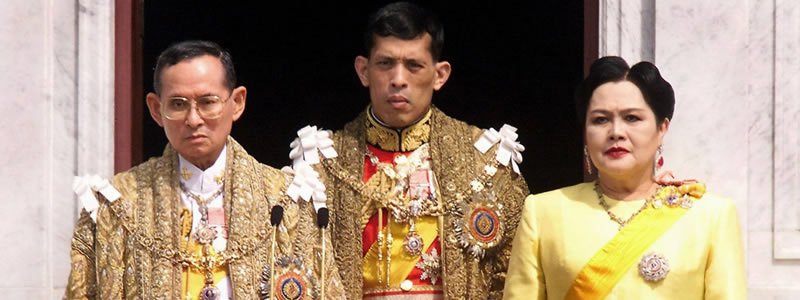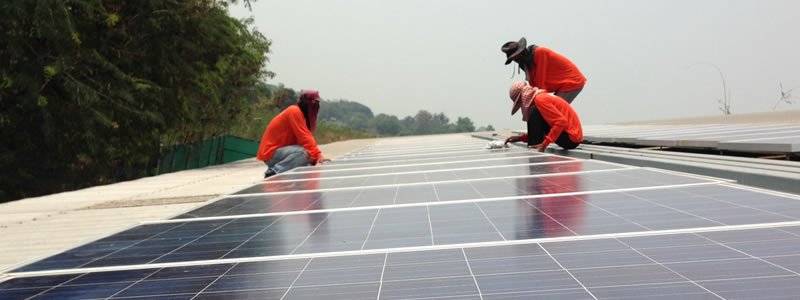
-
732 MW installed in the first nine months of 2016, up from 722 MW in 2015 and 470 MW in 2014, bringing cumulative installations to 2.75GW by the end of September 2016
-
2.62 GW of cumulative utility-scale capacity, with 130 MW of rooftop
-
Rooftop FITs range from 6.85 baht/kWh for residential arrays to 6.01baht/kWh for large commercial projects, over periods of 25 years
Thailand is Southeast Asia’s leading solar market, with 2.75GW of installations by the third quarter of 2016, according to the Energy Regulatory Commission (ERC).
However, while the country is an attractive investment opportunity — the government is targeting 6GW of cumulative PV installations by 2036 — muddled policies and fresh uncertainty over the recent death of the country’s long-reigning king have arguably complicated the short- to medium-term outlook.
There’s opportunity in Thailand. It’s simmering at the moment, but ultimately there will be another rush.
“There’s opportunity in Thailand. It’s simmering at the moment, but ultimately there will be another rush,” says James Munro, Bangkok-based project manager for Modern Energy Management, noting that the government is still figuring out how to support development. “There’s going to be another wave in the foreseeable future.”
That said, annual PV installations have risen steadily over the past five years, with capacity additions spiking to a record 722MW in 2015, up 252MW from a year earlier. Thailand also boasts a formidable solar resource, ranging from an annual average of 1200-1400 kWh/sqm, depending on the region.
Death of a Monarch
Industry experts tell Solarplaza that the political instability that has long plagued Thailand — most recently culminating in a 2014 military coup — should not present a threat to foreign investment.
“Projects still go ahead, banks are still willing to lend — it’s still quite stable,” says Munro.
Christopher Osborne, partner at international law firm Watson Farley & Williams (Thailand), agrees that the current military junta should not scare off foreign investors.
“It is a non-issue. Thai politics has been in a state of turmoil for decades and this has not led to business instability in the energy sector,” he argues.
However, it’s still too early to determine the long-term implications of the recent death of King Bhumibol Adulyadej, or Rama IX, as he was also known.
The king — the only constitutional monarch that most Thais have ever known, as he reigned from 1946 until his death at the age of 88 in October — was widely revered. Furthermore, he long served as a calming influence through multiple years of political instability.
Industry experts insist that it’s unlikely that there will be any significant political fallout from his death in the near term.
“Right now politics is probably the last thing on the mind of most Thais… we do not expect political instability,” says one Bangkok-based project advisor on the condition of anonymity, explaining that the immediate national reaction to the king’s demise has been one of profound loss and mourning.

However, King Bhumibol’s death undeniably marks a turning point in the country’s political history. And there are no guarantees that his son, Crown Prince Maha Vajiralongkorn — as unpopular as his father was loved — will be able to assume the throne in a smooth manner.
Among other concerns, there are fears that the mere presence of the prince — a flashy playboy who has lived much of his life outside of the country — could reignite long-simmering tensions between the rural poor and the more economically privileged class that lives in cities such as Bangkok.
Complicating matters further, it’s unlikely that many Thais — cowed by a strict lèse-majesté law that imposes harsh penalties on anyone perceived as criticizing the monarchy — will be willing to comment in a frank, open manner on the potential implications of the king’s death to prospective investors.
Politics and concerns over the monarchy aside, Osborne notes that government offtakers such as the Electricity Generating Authority of Thailand (EGAT) are widely perceived as bankable entities by institutions such as the Asian Development Bank.
“We have seen greater political risk in Spain, where the government retrospectively cancelled renewable energy incentives,” he adds.
Thailand also offers a mature, transparent and competitive project finance market. It is arguably the most advanced in Southeast Asia for solar at this point, in terms of lender experience and risk comfort, with non-recourse financing available from numerous institutions, including Kasikornbank..
Utility-Scale Uncertainty
Ground-mount projects account for 95.3% of the capacity that has been installed thus far. Such arrays were initially built under a generous “adder” scheme, introduced in 2011. However, Bangkok decided to scrap the program at the end of 2015, in response to declining PV system costs.
The only way for developers to build utility-scale projects now is in collaboration with government entities and agricultural cooperatives, under a program launched in 2014 with an initial target of 800 MW, for projects up to 5 MW in size. However, the introduction of the scheme was repeatedly delayed, resulting in the allocation of just 281.32 MW of capacity earlier this year. And as much as half of that capacity may not be built, due to a lack of clarity over the structure of the private-public partnerships.

Image: Thai Global Energy Co.
Since its introduction, Bangkok has divided the program into two phases, with the second tranche to support the development of 519 MW at a feed-in tariff rate of 5.66 baht/kWh over 25 years, to make up for the shortfall of the initial roll-out. Applications for the second phase will likely be launched by early 2017, with projects to be completed by June 2018.
Despite the program’s shortcomings, investor interest remains high. “There is strong demand among both Thai and international developers,” says Osborne.
It is likely that utility-scale PV will contribute towards the government’s long-term renewables targets, given Thailand’s proven PV resources.
He advises investors to focus on the scheme for the next two years, by which time power-purchase agreements (PPAs) for ground-mount arrays may open up again, beyond the scope of the government’s current program.
“It is likely that utility-scale PV will contribute towards (the government’s long-term renewables targets), given Thailand’s proven PV resources,” Osborne argues.
Yet the scheme remains fraught with uncertainty, with industry observers complaining that it has encouraged a “race to the bottom,” as developers succumb to the concessions demanded by the cooperatives, much like reverse auctions can lead to margins so thin that projects become unviable.
“The framework also doesn’t come with details on how communities can get involved or benefit,” laments Dr. Sopitsuda Tongsopit, a researcher at Chulalongkorn University’s Energy Research Institute.
Bangkok says it may eventually introduce an auction process for utility-scale PV, but Tongsopit believes this probably won’t happen until the full 800 MW from the current scheme has been built. She says developers should consider the program for now, but warns that more subsidies will be unlikely in the future.
Recent developments do not suggest rolling out utility-scale solar is an immediate policy priority, which may be linked to recent lower global gas prices.
Phil Napier-Moore, lead energy advisor at Mott MacDonald, partly attributes the currently sluggish development of the utility-scale market to the government’s use of renewables as a hedge against future import prices for liquid natural gas, rather than for environmental motivations.
“Recent developments do not suggest rolling out utility-scale solar is an immediate policy priority, which may be linked to recent lower global gas prices,” he concludes. “Utility-scale solar’s future in Thailand depends on demonstrating a levelized cost substantially equivalent to what could be expected from gas-fired generation plants.”
Rooftop Focus
Another more immediate investment opportunity is the rooftop segment. The government has already subsidized two rounds of development, but interest in commercial projects — driven in part by recent legal changes that allow developers to sell electricity to consumers — has far exceeded bids for residential arrays.

Image: VE Solar
Under a new pilot scheme, the government is now trying to encourage the installation of rooftop PV for self-consumption purposes, rather than feeding electricity to the grid, with the aim of eventually introducing net-metering.
Thomas Chrometzka, director of renewable energy at GIZ Thailand, argues that incentives are probably not needed for commercial rooftop, as developers are already negotiating private PPAs for such installations.
However, the outlook for residential rooftop remains uncertain under the government’s pilot scheme.
“We have our doubts,” Chrometzka says, noting that excess electricity fed back into the grid is not compensated under the program. “We were a bit disappointed as we recommended the government to go for a net-metering system and to not focus on this small-scale stuff.”
